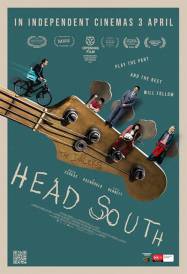Fantastic Beasts: The Crimes of Grindelwald
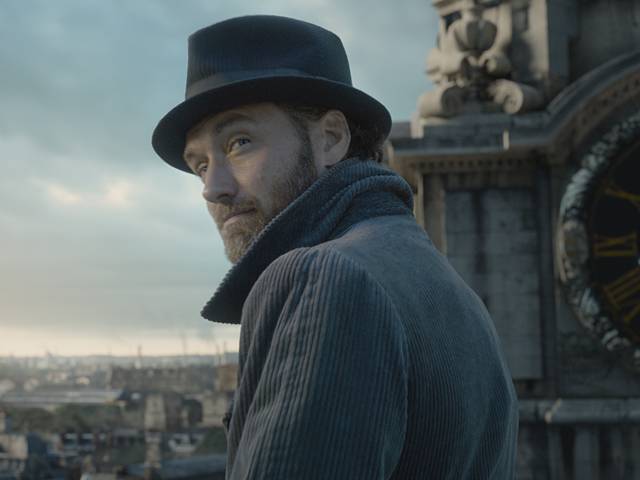
The Fate Of One… The Future Of All
Cast: Johnny Depp, Eddie Redmayne, Jude Law, Ezra Miller, Katherine Waterston, Carmen Ejogo, Zoë Kravitz, Dan Fogler
Director: David Yates
Genre: Adventure, Family
Rated: M
Running Time: 134 minutes
Synopsis: Warner Bros. Pictures' "Fantastic Beasts: The Crimes of Grindelwald" is the second of five all new adventures in the Wizarding World™ created by J.K. Rowling.
At the end of the first film, the powerful Dark wizard Gellert Grindelwald (Johnny Depp) was captured by MACUSA (Magical Congress of the United States of America), with the help of Newt Scamander (Eddie Redmayne). But, making good on his threat, Grindelwald escaped custody and has set about gathering followers, most unsuspecting of his true agenda: to raise pure-blood wizards up to rule over all non-magical beings.
In an effort to thwart Grindelwald's plans, Albus Dumbledore (Jude Law) enlists Newt, his former student, who agrees to help, unaware of the dangers that lie ahead. Lines are drawn as love and loyalty are tested, even among the truest friends and family, in an increasingly divided wizarding world
Fantastic Beasts: The Crimes of Grindelwald
Release Date: November 15th, 2018
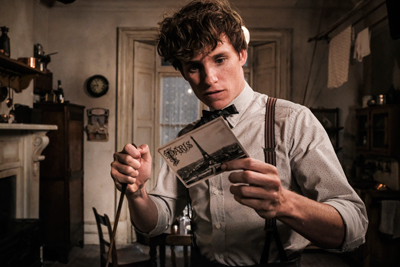 About The Production
About The Production
Two years ago, "Fantastic Beasts and Where to Find Them" transported audiences back to the wizarding world that has captured their hearts and ignited their imaginations.
Screenwriter and producer J.K. Rowling offers, "Within the 'Fantastic Beasts' franchise, I am telling a story that is only hinted at in the Harry Potter books"the rise of Grindelwald, who profoundly threatened both the wizarding and non-wizarding worlds, and his antagonist, Dumbledore, who, of course, is a key figure in the Potter stories. Grindelwald is first mentioned in Harry Potter and the Philosopher's Stone, so he was there from the beginning though he was more of a mysterious background character. You know he must have been important to figure so prominently in Dumbledore's own history, but it is only when you reach the end of the Potter series that you find out just how important he was…and you might also intuit that there must be much more to tell. I think this was the story I was most interested in revisiting because it's so crucial to understanding Dumbledore, who is my favorite character," she acknowledges.
At the helm of his sixth Wizarding World adventure, director David Yates recalls, "When Jo [Rowling] sent me the new script, my first impression was how different it felt to the first film we had made. This story is more layered and more intricate, with new character strands developing, and it's also a lot darker. But what really blew me away was how she created this feeling of an emotional thriller, with twists and turns I never saw coming. Jo is constantly evolving the universe she's built and, for me as a filmmaker, that makes coming back inspiring and always challenging." "Fantastic Beasts: The Crimes of Grindelwald" once again teamed Yates and Rowling with producers David Heyman, Steve Kloves and Lionel Wigram. Heyman, who has produced all the Wizarding World movies, adds, "Jo invents stories that are so richly conceived and entertaining, with such vividly realized characters. There are themes in the film which are in some ways along similar lines to Potter"good versus evil, love and loss, friendship and loyalty, identity and feeling outcast...
There is also a strong thread about choices"choosing to take a side, or not"and the impact that has, not only on an individual but on everyone around him or her. These are universally relatable ideas that transcend any one time or place, so even though the story unfolds in a magical world, it's like holding a mirror up to our own."
Yates agrees. "Jo's stories are not just for our time, they're for all time. She has an extraordinary ability to tap into themes that speak to people of diverse generations and cultures. One reason is that her heroes are not always obvious because they're often underestimated."
Much has transpired since Magizoologist Newt Scamander departed New York for London, leaving a hopeful Tina Goldstein on the dock, and since Queenie Goldstein entered the bustling bakery owned by No-Maj Jacob Kowalski, who"despite having his memories obliviated"seems to show a somewhat bemused spark of recognition. In the months that have passed, Newt completed his book, Fantastic Beasts and Where to Find Them, which has become a bestseller. Queenie and Jacob have begun a furtive romance in violation of the American wizarding world laws forbidding it. And their relationship has caused a rift between Queenie and her sister, Tina, who, having been reinstated to MACUSA's Auror ranks, is responsible for enforcing those laws.
Reprising the role of Newt, Eddie Redmayne notes, "For the first movie, J.K. Rowling created four unique characters, all of whom were outsiders and struggling in their own way. It is only through the connections they develop with each other"through that symbiosis"that they thrive and find happiness and even love. But in the interim, through miscommunication and circumstance, things have shifted."
Rejoining Redmayne as the original quartet are Katherine Waterston as Tina, Dan Fogler as Jacob, and Alison Sudol as Queenie. Waterston comments, "When we met these characters, they were all struggling to come into their own, but hadn't quite gotten there yet. I found it was very compelling to explore how the important relationships in our lives push us, enlighten us, and help us grow. And J.K. Rowling has brilliantly weaved that idea"of the power of friendship"throughout this continuing, ever-expanding story."
For all the actors, one of the most exciting aspects of coming back for the second film was that "the roots of this story are embedded in the Potter lore we all know and love," says Redmayne. "The histories that were only touched on before are being torn open and explored. And the stakes are that much higher."
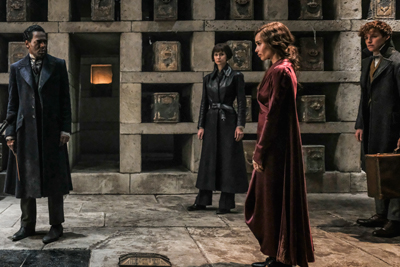 The links to Potter are immediately evident as, near the start of the film, Newt is mysteriously summoned by his former professor, now mentor and friend, Albus Dumbledore. Taking on the role of the beloved character, Jude Law is quick to clarify, "This is the Dumbledore who is not yet the great Headmaster at Hogwarts. He is closer to the formative, and more traumatic, experiences in his life that perhaps color him. What was especially interesting for me"and for us as a team"was to try and layer in foundation points that keep him closely related to the Dumbledore we know, but with room to grow and learn and to make mistakes. And the stories we're telling will show the evolution of the character."
The links to Potter are immediately evident as, near the start of the film, Newt is mysteriously summoned by his former professor, now mentor and friend, Albus Dumbledore. Taking on the role of the beloved character, Jude Law is quick to clarify, "This is the Dumbledore who is not yet the great Headmaster at Hogwarts. He is closer to the formative, and more traumatic, experiences in his life that perhaps color him. What was especially interesting for me"and for us as a team"was to try and layer in foundation points that keep him closely related to the Dumbledore we know, but with room to grow and learn and to make mistakes. And the stories we're telling will show the evolution of the character." Wizarding World aficionados know there is one figure from Dumbledore's past who is inexorably tied to his evolution: Gellert Grindelwald. Arrested by MACUSA at the end of "Fantastic Beasts and Where to Find Them," Grindelwald proves his powers are not to be underestimated" escaping in dramatic, and lethal, fashion. Once free, Heyman relates, "He begins to engineer events to further his cause: that wizards no longer have to live in secret, and that they should emerge from the shadows and be the dominating force in the world. He truly believes wizards are superior and should act accordingly. And he is very persuasive."
Yates says Grindelwald is a very different type of villain from the evil Lord Voldemort. "If you disagreed with Voldemort, he would kill you in an instant. But Grindelwald is incredibly beguiling. He would rather win people over to his side than annihilate them, and he is smart enough to understand you have to win hearts and minds, not coerce people, to gain their allegiance. So, whereas Voldemort was something of a thug, Grindelwald is a much more sophisticated player…and all the more dangerous for it."
Johnny Depp, who returns as Grindelwald, adds, "There is a rhythm to the way Grindelwald speaks, a cadence, that draws you in. Ultimately, what I felt about the character in terms of his presence is that it would be an exercise in stillness. I mean, his words are important, but what's even more important with Grindelwald is the subtext of those words. It is the dialogue that's silent"the meaning between the lines. It's almost hypnotic."
Grindelwald's ability to enthrall the masses leads to what Yates defines as a pivotal theme of the story. "These are circumstances when some characters will ultimately have to decide what they believe in. Will they choose a side or stand passively by and watch the world consumed in flame? That resonates throughout this film. And Jo has woven that into the search for the identity of one of the main characters who was known as Credence Barebone."
Played by Ezra Miller, Credence was revealed in the last film to be an Obscurial"a born wizard whose powers were suppressed to the point of becoming an Obscurus, a parasitical force deadly to its host, usually at a very young age. Rowling says, "You could justifiably have believed Credence had been killed, but, in fact, you can't kill an Obscurial when they're in Obscurus form. He survived, but the big question for him now is, 'Who am I?' His quest for his true identity is what propels him and becomes one of the major story strands in this movie. Who is Credence?"
Miller offers, "As she's done at every stage, beginning with Harry Potter, J.K. Rowling has taken the story to a new level of intrigue. She's delving even deeper into ideas that permeate all of her works"about the magic that exists in the connections between people, and people trying to find each other…and themselves."
Credence's search for his identity directly or indirectly affects almost every other character in the film, including Credence's friend and confidante, Nagini, played by Claudia Kim; a French-African wizard named Yusuf Kama, played by William Nadylam; Newt's older brother, Theseus, played by Callum Turner; and Theseus's fiancée, Leta Lestrange, played by Zoë Kravitz, whose picture was seen in Newt's workshop in the previous "Fantastic Beasts" film.
"I loved the first movie," Kravitz states, "and it was amazing to see it knowing I would soon be part of this incredible world of witchcraft and wizardry. But this film is a bit deeper, playing with some interesting ideas in the place between the dark and the light. It asks, 'Which path will you take?'"
The main cast also includes Kevin Guthrie and Poppy Corby-Tuech as Abernathy and Rosier, two of Grindelwald's inner circle, and Brontis Jodorowsky as Nicolas Flamel, a familiar name to fans.
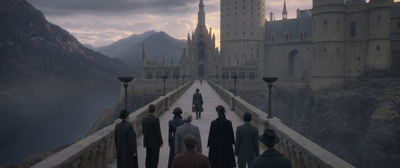 "We can relate to these characters and the journeys they're on," Heyman remarks. "But a film can only be as good as the people working on it, so we are fortunate to have the very best, both in front of and behind the camera, all pushing the envelope to make each movie better than the last. David Yates is an extraordinary director. He captures the essence of each character in the most beautiful way and is also able to marshal thousands of people in pursuit of a single vision. And he does it by inspiring, encouraging and paying attention to every detail. We also had the benefit of many people from the first film again collaborating with David, including Stuart Craig, Colleen Atwood, Philippe Rousselot, Mark Day, Tim Burke, Christian Manz, Fae Hammond and James Newton Howard. It adds great continuity as we bring the next chapter of the story to the screen."
"We can relate to these characters and the journeys they're on," Heyman remarks. "But a film can only be as good as the people working on it, so we are fortunate to have the very best, both in front of and behind the camera, all pushing the envelope to make each movie better than the last. David Yates is an extraordinary director. He captures the essence of each character in the most beautiful way and is also able to marshal thousands of people in pursuit of a single vision. And he does it by inspiring, encouraging and paying attention to every detail. We also had the benefit of many people from the first film again collaborating with David, including Stuart Craig, Colleen Atwood, Philippe Rousselot, Mark Day, Tim Burke, Christian Manz, Fae Hammond and James Newton Howard. It adds great continuity as we bring the next chapter of the story to the screen." Adding to the action, and the fun, the beasts are also back, including the familiar Bowtruckle named Pickett, and the sparkle-obsessed Niffler, who now has a brood of baby Nifflers. There is a wide range of new creatures, including the ferociously huge feline Zouwu, the green underwater Kelpie, and the skeletal winged Thestrals, also seen in the Potter movies.
Broadening our view of the wizarding world, the film takes us to Paris, which was created on the backlot at Warner Bros. Studios Leavesden in England. Rowling notes, "One of the great joys of the 'Fantastic Beasts' series is how free I am to take the story to different countries and explore other aspects of the magical world. I sometimes look back and think, 'My goodness, seven books, eight movies, all set largely in a school. How did we do that?'" she laughs.
That school, of course, is Hogwarts and fans have already expressed their excitement at seeing again the iconic silhouette of the castle. Yates attests, "It doesn't matter where you are in the world…when the camera flies over those mountains and you suddenly see that school at the end of the lake, you can feel the ripple of anticipation in the theatre. So it's a pleasure to be able to take the audience back and experience again the magic of Hogwarts."
The Cast
I cannot move against Grindelwald. It has to be you. - Albus Dumbledore
Newt Scamander had every intention of returning to New York to keep his promise to hand deliver a copy of his new book to Tina Goldstein. However, the British Ministry of Magic, still vexed by the mayhem he and his creatures caused across the Pond, has banned him from traveling internationally. They will lift the ban only on the condition that he join his brother, Theseus, in the Auror Department to accomplish one mission: hunt down Credence, who, Newt is stunned to learn, is still alive. Nevertheless, Newt"knowing the Ministry's intention is to kill Credence, whom they consider to be a threat"rejects their deal.
Redmayne adds, "What I love about Newt is that he's true to himself and not trying to please anyone else. His passion for creatures is uniquely his own, and he refuses to bow to other people's notions of what normal should be. Newt has always taken his own route through life and though he can be empathetic, he doesn't want to be pulled to anyone's side. But because of what's happening in the world and because the stakes are becoming so much higher, there may come a moment when he will have to choose a side. And that's part of his journey."
Yates observes, "There is a slightly more serious edge to Newt this time around, and Eddie embodies every facet of the character. He is a joy to work with…full of ideas and endlessly inventive."
Newt has no sooner declined the Ministry's offer when he is enlisted by someone else to find Credence, albeit for very different reasons. Standing atop St. Paul's Cathedral in the heart of London is Albus Dumbledore, who, in his singular way, offers Newt a hand up to join him.
Jude Law acknowledges there were specific challenges to playing "this much-loved character." He expands, "We knew it was key that we separate this Dumbledore from the one we've all known. He's decades younger and still has a lot to experience…and a lot to learn. It was important to remind ourselves that while he is a gifted wizard and a good man, he is also a troubled man; he has secrets and he has flaws, just as we all do. I also love his cheekiness"his brilliance allows him to be somewhat anarchic and rebellious"and being able to layer in those complexities and nuances freed me up hugely.
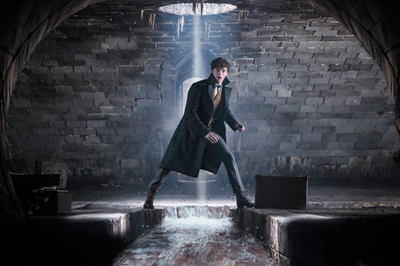 But most of what I did came down to really listening to Jo, who was exceedingly generous with her time and her insights. Her passion and tremendous sense of responsibility for her creation is infectious."
But most of what I did came down to really listening to Jo, who was exceedingly generous with her time and her insights. Her passion and tremendous sense of responsibility for her creation is infectious." As she has with other cast members, Rowling entrusted Law with closely guarded details about his character, noting, "I thought it was important that, from the moment we see him on screen, Jude knows the burden Dumbledore is carrying. Because without that knowledge, he would be portraying someone who appears to be playing games with people's lives, and that's not who Dumbledore is; he doesn't want to hurt anyone. Rather, there is humor in the way he has a little fun. However bleak things get, he always has that slightly mischievous side, and Jude did a wonderful job conveying that."
For Yates, Law possesses specific attributes that made him the right choice for the role. "First of all," the director says, "he's utterly charming and is quite sly and funny with that same twinkle in his eye. But more than anything he has a kind of natural grace. So apart from being a great actor, I thought he had all the qualities to be a perfect Dumbledore."
"In this film," Rowling says, "we largely see Dumbledore through the eyes of Newt Scamander, who is one of the very few people to call him on his secretiveness and his tendency to manipulate people. At the same time, Newt has an innate respect for Dumbledore because he was not only his favorite teacher but is also one of the greatest wizards alive. They have a very interesting relationship, but it's very unlike the one we saw with Harry Potter. It's much more a relationship of equals."
Redmayne has a similar perspective. "Newt realizes he is being manipulated by Dumbledore, but he's a bit too wily to be exploited and demands some transparency. That's where it becomes a level playing field. Dumbledore can only achieve what he needs through the skill set that Newt has and by counting on their friendship."
Dumbledore entreats Newt to go to Paris to find Credence, knowing Grindelwald will also be seeking to use him to his own ends. Perhaps the only wizard whose powers are as formidable as Grindelwald's, "Dumbledore would be the obvious choice to face off with him," Law says. "I believe, if circumstances were different, he would take on the challenge, but for the moment, he has to rely on Newt. Albus is one of those people who operates three steps ahead of everyone, so he knows Newt will ultimately make the right decision because he is brave and has a strong moral compass."
There is a reason Dumbledore cannot personally attack Grindelwald. It's a secret buried in their past. A secret he does not disclose to Newt.
Yates offers, "Dumbledore and Grindelwald met when they were very young, and they shared a philosophy, an ideology, of how the world should work"how they could make it better. For a season, they encouraged and inspired each other, and then, ultimately, they fell apart. But there is something about that relationship that remains compelling to both of them."
"You feel the bond Dumbledore had with this man is still very much there," adds Heyman. "There is a sense of loss and also regret. That being said, he doesn't like who Grindelwald has become or the path he has chosen. But he is not in a position to stop him himself."
Revealed as Grindelwald at the end of the first "Fantastic Beasts," Johnny Depp says he relished the opportunity to immerse himself fully in the new film's title role. "I could not be more honored to have been invited into this world by David Yates, David Heyman and J.K. Rowling. I felt thoroughly humbled to be thought of for anything in one of J.K.'s brilliant stories because I admire her so much. When the idea first came around, she and I talked for hours, and what amazed me was Jo never once dictated to me how Grindelwald should be. She gave me information to build the structure, and so you work within the boundaries of that structure, but she was also very open to my ideas. One of the most beautiful things I've ever heard in my career was when Jo said, 'I can't wait to see what you do with the character.' Obviously, all these characters are very precious to her, so for her to trust me to that degree was very exciting and such a boost of confidence."
The actor continues, "One of the things David, Jo and I talked about was that it would have been simple to play Grindelwald as just a bad guy, but he is doing what he truly believes is right, at whatever cost. His whole pitch is about harmony, but within his parameters"meaning the only way to achieve that harmony is through wizarding world domination and by understanding that there are people who are expendable. If they are in the way, then they must be dispatched. And he's pretty calm about it," he smiles.
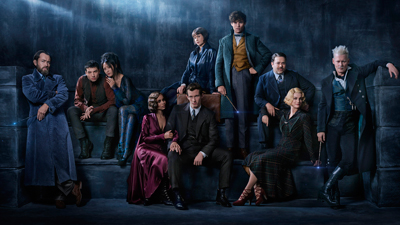 Yates recalls, "Because we were forging the character for the first time, we experimented quite a bit. Obviously, the guiding principle came from Jo"Grindelwald is charismatic, he's seductive, and he's dangerous. But in exploring the character, we also improvised some because we wanted to discover those different levels in the moment and as the camera turned."
Yates recalls, "Because we were forging the character for the first time, we experimented quite a bit. Obviously, the guiding principle came from Jo"Grindelwald is charismatic, he's seductive, and he's dangerous. But in exploring the character, we also improvised some because we wanted to discover those different levels in the moment and as the camera turned." "As an actor," Depp says, "your job is to be true to both the writer's intent and to the vision of the director, so I try to give the filmmakers options. And David's mind is so connected to J.K.'s works. He understands her artistry, almost like understanding the brushstrokes of a great painter."
Newt, you never met a monster you couldn't love.- Leta Lestrange
While at the Ministry to appeal his travel ban, Newt unexpectedly runs into Leta Lestrange. The name Lestrange will strike a familiar chord with Wizarding World fans, but Zoë Kravitz says Leta herself is something of an enigma. "She is from one of the most established pure-blood wizarding families, and I understand that comes with certain preconceived notions. But Leta isn't quite sure where she fits in, in terms of being good or bad. I think she is somewhere in between, as we all are. She's quite complicated and her journey is very intense because of a secret from her past that unravels over the course of the story. As an actor, it was an interesting path to go down for sure."
During their time as classmates at Hogwarts, Leta and Newt were both outsiders, but they found in each other a kinship. "I love their relationship because it's their oddness that brought them together," Kravitz smiles. "On paper, their friendship might not make as much sense, but Newt is such a compassionate person. He loves creatures"monsters no one else would love"and Leta sees herself as that in a lot of ways. Newt is the only one who really sees her for who she is and doesn't want to change a thing, and she needs that in her life."
"Zoë brought such texture to Leta," Yates says. "She was full of good ideas and fearless about trying different things, and I love that in actors. She was always keen to push and push to create the most engaging and multifaceted version of her character."
"David is so wonderful," Kravitz responds. "He has so much passion and care for this world and the people in it. These are big productions and it's easy sometimes to get lost in all of that, but he fosters an environment that still feels incredibly intimate and makes it a very safe place for an actor to explore their emotions."
Leta is now engaged to Newt's older brother, Theseus Scamander, which Rowling calls "a twist neither of them would ever have seen coming. It creates some awkwardness in their current relationship because Newt once had strong feelings for the woman who is about to become his sisterin-law."
Cast as Theseus, Callum Turner says he grew up reading the Harry Potter books "and went to bed most nights hoping Hedwig or one of her owl friends would come and drop a letter saying I was going to Hogwarts," he laughs. The actor goes on to reveal an impromptu move during his reading with Redmayne that he believes landed him the role. "Just before we started the scene, I kissed Eddie on the forehead, and I think that's the moment they said, 'Okay, we've got to give him the job." Heyman says, "Callum is a terrific addition to our cast. Together, he and Eddie really captured the brothers' complicated relationship."
"Newt is Theseus's younger brother and he loves him," Turner states, "but they have taken totally separate paths in life. Theseus was a war hero who became part of the establishment and has risen pretty high up in the Ministry of Magic, where he heads the Auror Office. That's how he decided to fight the good fight, even though it has often put them at odds. But now there is more at stake" the wizarding world is splitting into camps, and Theseus warns Newt that everyone, even he, is going to have to decide which one they're in."
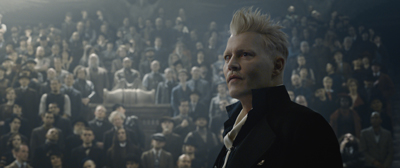 The potion only erases bad memories. I didn't have any. - Jacob Kowalski
The potion only erases bad memories. I didn't have any. - Jacob Kowalski News of Leta's engagement has spread throughout the wizarding world; however, tabloids have erroneously announced that best-selling author Newt, not Theseus, is the Scamander betrothed to Leta. "It's all a mistake, but Tina doesn't know that," relays Katherine Waterston, who again plays Tina Goldstein. "She and Newt had been maintaining a correspondence, but now Tina thinks she's been jilted and abruptly cuts him off. Though she's hurt and mad, she's also strong and knows she must get on with her life, so she pours all of her energy and focus into her work"her go-to way of coping with painful things. So off to Paris she goes."
Newt might never have learned why her letters suddenly stopped had he not gotten a surprise visit from two dear friends: Tina's sister, Queenie, and No-Maj Jacob Kowalski, whose memories have somehow been restored. And there is other engagement news: Queenie gleefully announces that she and Jacob are also getting married. Jacob appears happy about it…perhaps a bit too happy.
Returning as Jacob, Dan Fogler attests, "Newt notices pretty quickly that something is wrong because Jacob is acting a little too jolly, and he quickly deduces why. It turns out Queenie has put Jacob under a love spell. The scene was so much fun to play, but what's great about it is that even though it's a fantasy involving magic and spells, what happens between them is rooted in real relationship dynamics. That's why it feels so tangible."
Alison Sudol, who reprises the part of Queenie, adds, "There is a reason J.K. Rowling is one of the preeminent storytellers of our time. The magic in her stories is wonderfully entertaining, but she also delves into deeper topics, like what happens when people are made to feel wrong for who they are and what can arise out of fear of the 'other.'
"In the last film," Sudol continues, "Queenie was already breaking the rules by going back to Jacob because the wizarding world in America has stringent laws about what kind of interaction you can have with No-Majs, which is basically none. But Queenie has never fallen in love the way she's fallen for Jacob, and she's desperate not to lose him. That pushes her to make not the wisest of choices, even though it's done out of love. She is going to have Jacob whether Jacob likes it or not…but her plan doesn't work out very well."
Jacob does love Queenie, which is exactly why he is willing to sacrifice his own happiness to keep her safe and out of trouble. Nevertheless, he is also understandably unhappy about not being given a choice in the matter before being dragged across the ocean to England, where, as Queenie knows, the laws of fraternization between wizards and Muggles are more lenient. Unfortunately for Jacob, Queenie is a Legilimens and can read his harsh unspoken thoughts. "She is very hurt," Sudol says, "and runs away to find Tina, who is her only family, but she is alone and gets terribly lost."
However, Queenie leaves behind a clue to Tina's whereabouts. Now, in addition to Dumbledore's mission, Newt has a more personal reason to defy his international travel ban and go to Paris. Jacob, anxious to find Queenie and sensing a new adventure, is all too willing to join him. Yates calls the unlikely friendship between Jacob and Newt a "bromance." Fogler concurs, adding, "They are like a classic comedy duo"total opposites, physically as well as personality-wise. Newt is book smart and Jacob is street smart. Jacob is more of a people person and Newt is better with his creatures. Together, the two of them are like the right side and left side of the brain…they just work."
Although Tina has earned back her job as an Auror, she hasn't lost the independent streak that had gotten her into trouble in New York. Now she is in Paris on a wholly unauthorized quest. Waterston observes, "In the first film, Tina's core confidence was shaken because, after her demotion, no one would listen to her or take her seriously. Despite her insecurity, she continued to follow her instincts as an investigator, and was ultimately rewarded her old job when those instincts helped lead to Grindelwald's arrest. When we catch up with her in this film, she is back in the thick of it, pursuing leads, trying to find and, as promised in the first film, protect, Credence."
The actress reveals that Tina has personal reasons for again risking her career to save Credence. "Tina and Queenie were orphaned very young. Tina, as the elder of the two, felt a great responsibility to take care of her sister. Over the years, that feeling to protect helpless children extended beyond just Queenie. She values her position at work and respects the law, but a child in need"that's her Achilles heel. If forced to choose, she'll break the rules to help a child, as she did for Credence when Mary Lou Barebone was beating him. Near the end of the first film, she gave Credence her word that she and Newt would protect him, and she is not one to go back on her word."
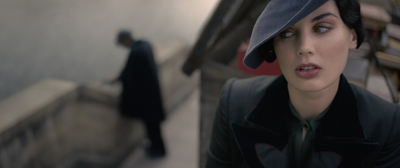 I want to know who I am. - Credence
I want to know who I am. - Credence Credence is also in Paris pursuing his own leads in a desperate search for his real identity. Reprising the role, Ezra Miller relates, "Credence is a young man with a severely traumatic history, who has finally cast off the chains of the abuse and repression that he suffered through his whole youth. He is now on an odyssey of self-discovery because much of what formed his perception of himself he now knows to be a lie."
Born a wizard, Credence's powers were suppressed by the merciless intolerance of his adoptive mother, Mary Lou Barebone, causing him to become an Obscurial. Rowling explains, "He developed an Obscurus, which is both a coping mechanism and something that will ultimately kill you. Except it hasn't killed him, so we know he must be very powerful to have survived this condition for so long."
Miller, who has shared that he was greatly impacted by the Harry Potter books growing up, adds, "A lot of us were already fans of this world; the stories of authors like J.K. Rowling are touchpoints of inspiration because they are one of the places where our imaginations took root. To be part of this legacy is one of the most extraordinary things anyone could experience as an artist and continues to be one of the great honors of my life."
Having been given a clue to his identity that points him to Paris, Credence took a job at a traveling wizarding world circus to get to France. There, he finds the first real friend he has ever known"a Maledictus named Nagini. Rowling clarifies, "A Maledictus is someone who carries a blood curse that, over time, turns them into a beast. They can't stop it, they can't turn back. They will lose themselves…they will become the beast with everything that implies."
In the case of Nagini"as every Harry Potter aficionado knows"the beast into which she is destined to transform is an enormous snake. While there is no hint in "The Crimes of Grindelwald" of the character's terrible future, Rowling discloses, "These movies have given me the chance to tell a story about Nagini's origin. There were always hints because the Naga are mythological snake beings, so her name was an allusion to the fact that she may have had human antecedents, or she may once have been human herself. Through the years I have been asked about it, but I never wanted to give away this dollop of her backstory. But now I get to reveal it, which is very satisfying and fits perfectly into the theme of this movie."
Cast as Nagini, Claudia Kim comments, "I loved playing this character, knowing who she is and also having a peek of what she will be in the future. There's still a gap that's a mystery, although J.K. Rowling did give us little hints. You always want to say, 'Give us more!' but she prefers to leave some things to be discovered. And I trust her and David Yates completely."
Nagini is a main attraction at Circus Arcanus, where the owner and Ringmaster, Skender, cruelly exploits magical Underbeings who have nowhere else to go. In describing her role, Kim says, "Nagini is a prisoner in this dreadful circus, but there is another layer to it because she is bound to become a prisoner in her own body. It's a place of utter hopelessness for her until she meets Credence.
I think it's his determination to find out who he is that gives her hope, and she becomes very nurturing and protective of him. All she wants to do is fight to remain a woman for as long as she can, but selflessly, she puts his objective ahead of her own desires, believing it will mend his brokenness. It becomes a strong emotional partnership between them."
"It's a heartbreaking story in many ways," says Yates. "Claudia delivered a very moving performance as a woman who is slowly losing herself. She is wonderful in the role."
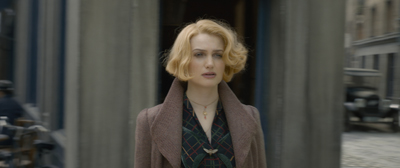 To embody the Maledictus and her inescapable metamorphosis, Kim worked with a movement coach and even went to a local zoo "to study the movement of snakes, so it would become almost instinctive," she recalls. "Unless they are attacking, snakes move very slowly and gracefully, and I tried to reflect that gracefulness in my performance."
To embody the Maledictus and her inescapable metamorphosis, Kim worked with a movement coach and even went to a local zoo "to study the movement of snakes, so it would become almost instinctive," she recalls. "Unless they are attacking, snakes move very slowly and gracefully, and I tried to reflect that gracefulness in my performance." Tracking Credence to Circus Arcanus in Paris, Tina notices someone else who is equally focused on him. William Nadylam joins the cast as the mysterious French-African wizard Yusuf Kama, who has a personal motive for hunting Credence down. "Kama is the son of a great wizard, the last male in his pure-blood family line. He is driven to fulfill a task that he has been pursuing most of his life," the actor says cryptically. "When Tina arrives, Kama realizes she is after the same target and must stop her from hindering him in any way. From then on, events take an unexpected turn, and he finds out things are not exactly as he believed they were. When I read the script, Kama's story touched me directly and I was completely immersed in this role. He is a fascinating character with a complex inner struggle."
"Kama holds many secrets in this movie, and you don't really know whose side he's on," says Rowling. "William is a marvelous actor who brings some real gravitas to the part."
In Paris, Newt does eventually need to take advantage of Dumbledore's offer of a safehouse, should trouble arise…or even just for a cup of tea. The address turns out to be the home of Dumbledore's oldest friend"quite literally"Nicolas Flamel.
Taking on the role of the ancient alchemist, Brontis Jodorowsky says, "Nicolas Flamel is well known to followers of the Harry Potter stories as the creator of the Philosopher's Stone. I understood how many people would be curious about him and his part in this story, so I felt a great responsibility to give life to this person in a way that meets their expectations but also brings some surprises."
It took approximately four hours in the makeup chair to add about 600 years to the considerably younger actor's visage. However, the time proved invaluable to Jodorowsky. He confirms, "Four hours of prep gives you time to completely get into someone else's skin because, little by little, you're erasing yourself and allowing the character to take over."
The film's ensemble cast also includes Carmen Ejogo, who reprises the role of MACUSA president, Seraphina Picquery; Ólafur Darri Ólafsson as Skender, the callous Circus Arcanus owner and Ringmaster; Ingvar Sigurdsson as the Ministry-hired bounty hunter, Grimmson; and Victoria Yeates as Newt's loyal assistant, Bunty. Grindelwald's inner circle of acolytes, who will go to any lengths in service to their master's cause, are the former MACUSA middle manager Abernathy, again played by Kevin Guthrie; Rosier, played by Poppy Corby-Tuech; Carrow, played by Maja Bloom; Krafft, played by Simon Meacock; Krall, played by David Sakurai; and Nagel, played by Claudius Peters. Yates offers, "We have a terrific cast, all of them lovely people to spend time with, and that matters when you are spending months together building one of these huge films. Every single one of them came to the process committed to doing their best work."
The Beasts
There are no strange creatures…only blinkered people.- Newt Scamander
Another ensemble is also featured in "Fantastic Beasts: The Crimes of Grindelwald": the array of magical creatures, including a few returning favorites. The tiny, sprig-like Bowtruckle, named Pickett, is once again Newt's constant companion, kept safely tucked away in his pocket. Pickett's innate ability to pick locks has also made him an invaluable ally.
The Niffler"a small, furry rodent-like creature with a long snout"is back, and still constantly on the lookout for anything shiny or glittery, which will inevitably wind up in his marsupial-like pouch.
Sharing that instinctive obsession with anything sparkly is a litter of baby Nifflers, who also seem to have inherited their father's proclivity for wreaking havoc wherever they go. "So there is not just one scene stealer, there's an entire family of scene stealers," Redmayne jokes.
As with the first film, the creation of the beasts entailed months of concept designs and animation tests to determine the appearance, movement, behavior and personality of each animal. Rowling based several of the beasts on the mythical creatures of various cultures, including the Chinese Zouwu, the Scottish Kelpie and the French Matagot. She affirms, "I'm fascinated by different mythologies and traditions, particularly when you're moving around the world, so where there is an existing creature in mythology, it just adds so much texture and color. But some things I totally have to invent, and I really enjoy that process, too."
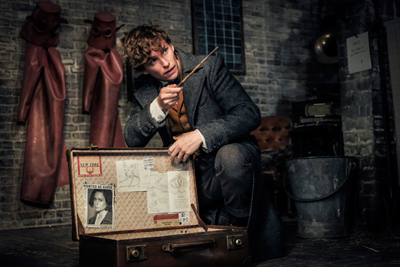 Heyman remarks, "Jo's descriptions in the script, as well as in the book Fantastic Beasts and Where to Find Them, were our starting point. From there, we had people from the art department and visual effects teams coming up with thousands of design ideas, and gradually, we would cull them down to the ones we were most excited about."
Heyman remarks, "Jo's descriptions in the script, as well as in the book Fantastic Beasts and Where to Find Them, were our starting point. From there, we had people from the art department and visual effects teams coming up with thousands of design ideas, and gradually, we would cull them down to the ones we were most excited about." Case in point was the Zouwu, the largest and most ferocious of the beasts. Visual effects supervisor Tim Burke says, "We had more than a hundred assorted concepts for the Zouwu. At one point, it resembled a more conventional big cat, but David Yates challenged us and said, 'Let's push this and really see how far we can take it.'" The final design is a massive feline with a tiger-striped body, a lion-esque mane that sparks when flared, sharp claws and four long fangs that curl up out of its mouth. One distinctly non-feline trait is its disproportionately long and ruffled multicolored tail. After escaping from Circus Arcanus, where it was severely abused, the injured Zouwu poses a threat to anyone unfortunate enough to cross its path…except Newt Scamander, who sees beyond its terrifying demeanor to the kitten within. Redmayne offers, "Newt believes that these creatures are just misunderstood, so his way of dealing with them is to have empathy and learn as much as he can to try and understand them. At his core, there is a strong ethos of compassion and conservation, and I admire that about him."
A group of puppeteers provided both the actors and the filmmakers with physical stand-ins for the beasts that would eventually be brought to life in post-production via visual effects. Supervising creature puppeteer Robin Guiver headed up the team, who had initially gained fame for their creation of the title character in Broadway's "War Horse" and also worked on "Fantastic Beasts and Where to Find Them." Guiver notes, "Having a tangible representation of a creature gave the actors something to act with and react to. And we could approximate the size, so David [Yates] and his camera department had a physical reference to frame up on. David could also direct our puppets just as he would an actor to establish his blocking for a scene."
The puppets ranged in size and materials, depending on the beast in question. For example, small bean bags were used to double the Niffler and baby Nifflers. Conversely, the enormous Zouwu required no fewer than three puppeteers, with one manipulating the large sculpted head and the others handling the body and nine-foot tail, which they could swish around on a pole.
One of the most challenging sequences involved Newt having to tame a Kelpie, which takes him on a wild underwater ride. The green Kelpie looks very much as its name suggests, "like a field of kelp," Burke illustrates. "And then it takes on more of a horse-like shape when out of the water."
For the underwater portion of the scene, Redmayne was filmed in a water tank, where he was pulled along by wires that the VFX team would later replace with the Kelpie. However, Burke details, "When he leaps out and rides across the surface, there was no way we could do that on a rig that would work in water. Instead"going with the theory that everything could be shot dry for wet, with the water added digitally in post"we came up with this basic buck rig for Eddie to ride, like a pommel horse without the handles. We had four stuntmen moving the buck around the floor, which allowed the camera to move freely around and get the best angles. At the head, we had Robin Guiver wearing a pair of stilts with a fabricated horse head, which he was puppeteering. It really gave Eddie something to work with"he was pulling on the reins, fighting the Kelpie's head, and you can see that in his performance."
The Kelpie is only one of Newt's collection of magical creatures in "Fantastic Beasts: The Crimes of Grindelwald." Two more animals in Newt's care are the Augurey, a large owl-like bird with sharp talons, a horned beak, colorful tail feathers and a very inquisitive face; and the Leucrotta, which deceptively seems to be nothing more than a large moose with long, jagged antlers, but when the Leucrotta opens its jaws, its mouth is cavernous.
Other beasts seen in the film include the feline Matagots, spirit familiars resembling hairless Sphynx cats, which are employed for security, as well as menial jobs, at the French Ministry of Magic; and Firedrakes, winged lizard-like creatures that might be mistaken for small dragons, except, instead of breathing fire, they emit sparks from the end of their tails that set anything ablaze.
Potter fans will immediately recognize the winged Thestrals, a skeletal equine beast with forked hooves and a pointed tail. Black in color, they are only visible to those who have witnessed death firsthand. The Thestrals are pulling the carriage transporting Grindelwald to Europe to pay for his crimes. And Gellert Grindelwald can clearly see them.
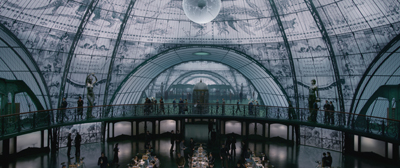 New And Familiar Places
New And Familiar PlacesNew York To London
"Fantastic Beasts: The Crimes of Grindelwald" was filmed almost entirely at Warner Bros. Studios Leavesden, the cinematic home of the Wizarding World for almost 20 years.
The story begins where the last movie ended: in New York, where, since his arrest, Grindelwald has been imprisoned in the cellblock located in the bowels of MACUSA. However, the European wizarding communities, impatient to make the Dark wizard pay for his crimes on their soil, have come to take custody of him…unaware that they are playing right into his hands. Grindelwald proves far more powerful than they even imagined and mercilessly turns the tables on his captors. Accomplishing the escape sequence required the close collaboration of multiple departments, including the VFX, SFX, and stunt teams. Visual effects supervisor Christian Manz states, "Grindelwald's escape was one of the biggest challenges for us because there were a lot of moving parts. They are flying over New York City at night through rain and lightning in a carriage painted gloss black, so it unfortunately reflected everything on the soundstage. Johnny Depp was atop the carriage being pelted with water and a lot of wind, and in every take, he handled it all fantastically."
The carriage set piece was mounted on a three-axis gimbal, which, says special effects supervisor David Watkins, "enabled us to make the escape a wild rollercoaster ride, for want of a better description, as Grindelwald takes over."
"But just to make everything a bit harder," Manz deadpans, "we added in broom riders because it made sense that there would be a security escort for such a dangerous prisoner." For the flying brooms, stunt coordinator Eunice Huthart utilized an updated rig called a tuning fork, which allows for more realistic movement than previous rigs.
On another Leavesden soundstage, production designer Stuart Craig created Newt Scamander's animal sanctuary and hospital, which is sequestered in the basement of his London townhouse away from the prying eyes of both wizards and Muggles. Craig remarks, "Some of the habitats in his basement are vast. With the help of visual effects, we could make them infinite, with landscapes and a giant lake and other natural habitats for the creatures."
Redmayne relates, "Newt lives in a deceivingly sparse London apartment, but in his basement, he has an absolutely mindboggling menagerie." Even though much of the set, as well as the beasts, was still to be finalized via VFX, the actor states, "Walking on that set was pretty breathtaking."
Supervising art director Martin Foley adds that, while the basement has been magically extended, it was designed to maintain the architectural style of the townhouse, the exterior of which was shot at a London terraced house. "We made it exactly as it would be"with that classic Georgian architecture"except it's huge. We also added the staircase cantilevered out of the wall, which was a nod to the moving staircases at Hogwarts."
The same shed that serves as Newt's workshop in the case that travels with him is also a fixture in his basement"a design choice that triggered a debate among the filmmakers about how that could possibly be. The answer, Craig slyly says with a smile: "It's magic."
Hogwarts
The return to Hogwarts School of Witchcraft and Wizardry was an unadulterated thrill for cast, filmmakers and crew alike. "Being back was wonderful," David Heyman attests. "We've expanded our universe since Harry Potter, but Hogwarts feels embedded in the wizarding world in a way that few other places are. It's like coming home."
The renowned British wizarding school had always conveyed a sense of timelessness, so there was no need for Craig to redesign it for the period of the 1920s, or even earlier, as seen in flashbacks of Newt's and Leta's school days. Foley says, "Hogwarts is hundreds of years old, and nothing's changed. That highlights the feeling of familiarity; you know where you are the moment you see it."
While the original designs hadn't changed, most of the physical sets are no longer intact, so a few had to be rebuilt, including Dumbledore's Defence Against the Dark Arts classroom. Craig acknowledges, "I'd forgotten quite how big it was, with its imposing roof trusses. I was pleased with that set the first time around and the second time was just as nice."
Jude Law says that the experience of stepping into the classroom as Dumbledore went beyond just acting. "The children in those scenes were so excited to be there, and I shared their excitement. My parents are both teachers, so I really enjoyed being a teacher for the day. Like everyone else, I've seen those classes in that schoolroom onscreen, so suddenly to be in that position was extraordinary. Sometimes acting is slightly out-of-body"you're there in the moment, but later, when you look back on it, you realise how special it was."
The instantly recognisable Great Hall was reduced to rubble in the battle at the end of "Harry Potter and the Deathly Hallows – Part 2." It was too large a set to rebuild for Leta's brief moment of nostalgia in this film, so it was recreated digitally.
One Hogwarts set never seen before is the small closet, which the younger Newt has turned into a secret refuge for some tiny creatures in need of his care…a harbinger of bigger things to come.
The Hogwarts exteriors and some interiors were shot at historic Lacock Abbey, which was originally built in 1229. The ancient site, located in Wiltshire, England, had served in the same capacity for several of the early Potter films.
Paris
With Credence as the catalyst, the various characters converge in Paris, where Gellert Grindelwald is marshaling his Dark forces in the City of Light.
"Why Paris?" Rowling poses. "In the first movie, we were in America, where the wizarding community felt quite locked down. For this film, I was looking to move to a place where there would be a more fluid relationship between the magic and the mundane. And in the 1920s, that had to be Paris. I have also lived in Paris and have ancestry from there, so I feel a connection to the city."
Rather than shooting in Paris, the filmmakers decided to bring Paris to the Leavesden backlot, where they would have a controlled environment, just as they had with New York for the inaugural "Fantastic Beasts" movie. Stuart Craig and his team began the design process by traveling across the Channel to photograph different areas of the city for the purposes of research and also to obtain plates that the VFX team would later utilize as backdrops to extend the city to the horizon.
"We went to Paris several times and took pictures of things we liked"streets, apartment blocks, shops…the most interesting things we could find," Craig notes. "We also had a professional researcher who put together an extensive pictorial archive, so we could make our Paris look as it did in 1927, in particular adding black sooty deposit on the buildings"the effect of air pollution resulting from the coal fires of the day."
"Stuart's sets are an amazing synthesis of artistry and logistics," says David Yates. "Not only does he come up with these incredible designs, but then he and his remarkable team build us entire worlds on a backlot. And he makes it look so easy."
The director's awe is shared by his fellow filmmakers and the cast. Dan Fogler confirms, "Stepping onto Stuart's sets never fails to amaze us. What he and the whole crew do is mind-blowing. You almost forget it's not real."
Rowling simply states, "You give Stuart one line of description and bang, he gives you a world." For Craig, it all starts with those descriptions "because Jo is very precise," he says. "It's a really enjoyable part of the job"taking her script stage directions and following the path she's charted. She's researched it all quite diligently, so hers is the ultimate seal of approval."
Whether in London, New York, Paris or places yet to come, Craig says the goal in designing the wizarding world is the same. "We try to make everything look absolutely real. When things appear totally credible, the magic is all the more effective. We don't try to build fantasy sets; we try to let the fantasy somehow be born out of seemingly real environments."
Hiding in plain sight, the entrance to the Parisian wizarding world appears to the Non-Magique (the French term for Muggle) to be nothing more than a statue. But when a wizard or witch approaches, the bronze figure comes to life to reveal the portal to the magical Place Cachée. "It's like Diagon Alley," Craig says, "but in Parisian style rather than early Victorian."
The shop window displays, arranged by set decorator Anna Pinnock, offer all manner of wizarding accoutrement, from cauldrons to Quidditch equipment to owl cages and, of course, wands.
And even in the wizarding world, no French quarter would be complete without an outdoor café. At the start of the film, the Place Cachée is the temporary home of Skender's Circus Arcanus. The art department erected three tents in the square, each holding various captive beasts and Underbeings. Enhancing the period look are festoon lights, as well as old-fashion circus posters heralding the attractions. The original posters were done by the graphic artist duo of Eduardo Lima and Miraphora Mina, better known as MinaLima, who have created the graphics for all the Wizarding World movies.
The VFX team added an unmistakably magical twist to more typical circus offerings. Christian Manz details, "We were coming up with things you might see at a normal circus or fair and one was people making giant bubbles that children love to chase after. We thought, 'Wouldn't it be fun if you could run and jump into one of the bubbles and fly off?' and David loved the idea. We also had a person juggling water, and fire eaters, except one blows the fire out and the other sucks it back in." The hub of the Parisian wizarding world is the elaborate Ministére des Affaires Magique, the French equivalent of the Ministry of Magic, in London, or MACUSA, in New York. In his approach to the set Craig says, "Jo specified Art Nouveau, and we really went for it. Every inch of it reflects Art Nouveau in its organic, twisting, curving designs."
Unlike the Ministries of London and New York, which were many stories high or deep, depending on your perspective, the French Ministry extends out horizontally in a series of large, interconnected domes. Entrance to the Ministry is gained through the animated roots of four trees in Place de Furstenberg. You arrive in the main atrium, which has a circular balcony overlooking the clerical staff at their desks.
"Art Nouveau is all about nature and often involves glass and light," Foley describes, "but the problem was that this Ministry is supposed to be below ground. Stuart wanted the design to negate that fact, so each dome has a faceted glass ceiling, radiating an ethereal glow that can straightaway make you forget you are underground. And on the ceiling of the main entrance, there are moving projections that represent a kind of zodiac of magical creatures"instead of Taurus or Scorpio there are other constellations in the form of a Graphorn or Hippogriff.
Plays of light were elemental to all of Craig's sets, so the designer collaborated closely with director of photography Philippe Rousselot. "Philippe doesn't just deal with light; he works with darkness as well, and that can be a very fine line," says Craig. "Shadows achieve a sense of mystery, and the results are beautiful."
Rousselot responds, "One thing that's great about working with Stuart is he thinks about lighting in his designs, so his team is building sets that are not only beautiful but also prone to imagination in terms of incorporating light. The sets are not just visually stunning"more than that, they are intelligently designed."
Within the French Ministry is the Department of Ancestral Records, which might hold a clue to Credence's identity. The complex set involved row after row of bookcases that magically rise up from the floor and then move in different directions and rotate. Special effects supervisor David Watkins explains, "We had a total of three bookcase rigs: one that could rise up and shift back and forth on a track; a stationary rig that rotated; and a third, which was a remote-control bookcase on mecanum wheels that we could drive in any direction."
The visual effects team was also involved in accomplishing the sequence"multiplying and animating the myriad bookcases that become obstacles in an action-packed chase scene. Tucked away in the heart of Paris, Nicolas Flamel's home"the safehouse Dumbledore provides to Newt"seems deliberately out of place for the times. Craig clarifies, "Well, he's about 600 years old, and that obviously invited us to go further back in time, way before Haussmann's Paris." The set, constructed on a Leavesden soundstage, was designed in a Tudor style. "It's a half-timbered building as it would have been built in the 15th or 16th century. And it was fun to do because it had to convey this great antiquity, so the timbers are rotting, and the place is absolutely filled with paraphernalia."
Foley adds, "We had to wrack the walls and the floors, and the beams are leaning. Everything has bowed and twisted with the weight of time."
One of the film's largest set pieces was an underground amphitheatre. "It's a classical amphitheatre of indeterminate age, but in the style of ancient Rome," Craig says. "It was a very big physical set, which was then made even larger with visual effects. Our collaboration with visual effects is very significant indeed. We often rely on them to give the movie its wider context, its scale." Tim Burke relates, "The amphitheatre Stuart designed was so enormous that we would never have been able to film it all in camera. They built about 25 percent, which held more than 600 extras.
We then replicated and extended it and filled it with more than 4,000 rendered characters." In the film's climax, Grindelwald stands at the center of the amphitheatre, rallying those thousands of wizards and witches to his cause.
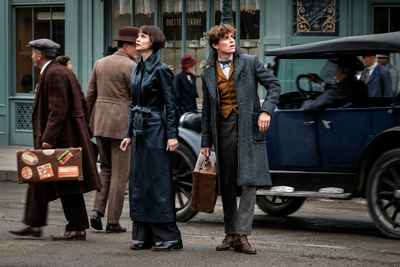 Costumes
Costumes Costume designer Colleen Atwood, who won an Oscar for her work on the first "Fantastic Beasts," came back for a second foray into the wizarding world. "This world was made for Colleen," Yates declares. "She is a true artist, and it's a wonderful canvas for her."
Atwood relished the opportunity to stretch her imagination with respect to the era and setting of the film. "I was excited about the prospect of exploring fashion in Paris in the late `20s. I pushed it into the early `30s because Paris is always ahead of the fashion curve; it's city known for its elegance and style and that was a great period for design."
In creating the costumes for the returning characters, Atwood wanted to mirror their evolution since the earlier film. "They have all matured a bit and are in another phase of their lives," she says. Starting with Newt Scamander, she notes, "Newt still has his beasts, but his shell is a little slicker. We put Eddie in clothes that are close to the same silhouette, just a bit better fit."
Atwood took a similar approach to Dan Fogler's Jacob, whose success as a baker is denoted in his natty new suit, "with all the pieces made out of the same matching fabric," she points out. Each of the Goldstein sisters has also undergone a noticeable change. The designer explains, "Tina has more self-assurance since her reinstatement as an Auror. She looks like a true detective in a great blue leather coat. We were fond of everything about it…except how much it weighs."
"That thing weighed so much; it was a workout just to put it on," Katherine Waterston confirms with a laugh. "But it really helped me to define her, so it was worth it. And Tina is still in her trousers because I felt strongly that just because she has grown more confident doesn't mean she's become a different person. That's the way she likes to dress and it works for her."
Tina's hairstyle is also markedly changed. Makeup and hair designer Fae Hammond notes, "We felt that when she got back to being an Auror, she would want to be more chic. And you can't beat a simple bob."
Similarly, Credence's transformation is outwardly reflected in both his clothes and his hair, which is no longer in an awkward bowl cut.
Alison Sudol had some input into Queenie's costume. Atwood affirms, "Alison had the idea that she'd like to be in plaid. I found an old piece of `30s plaid fabric that had the right feeling for the period and changed it up just a bit for her dress. It's a bit more grown up and has a slightly darker edge than her dress in the last film, but at the same time, it's feminine and has the whimsy of that big bow in the front. And Alison liked it, which is important to me."
Atwood also wanted to evoke the vivid and varied personalities of the people stepping into the story for the first time. For Nagini, she outlines, "Throughout the film, she is wearing her performance costume from the magical circus, so I wanted to amplify the fantasy aspect. For the material, I took lace and screened over it with metallic foil to give the look of snakeskin, and then added ruffles around the bottom and the sleeves to suggest the coils of the snake."
"I think Colleen really captured the beauty and the tragedy of Nagini in that dress," Claudia Kim comments.
Unlike Nagini, Atwood says, "Leta is from the manor born, so her clothes are all very elegant and rich in color. Zoë looks fantastic in anything, so it was fun to dress her for the period." One of the more daunting challenges was designing the costumes for Albus Dumbledore, for whom there might have been certain expectations. However, Dumbledore is years away from wearing the long, flowing robes that defined his wardrobe as the Headmaster of Hogwarts. Atwood remarks, "David Yates and I wanted Dumbledore to be the professor the kids all love, their go-to guy. He needed to look professorial but at the same time approachable, so I used softer fabrics and textures in tones like heathery grays, which add to the approachability of the character. I also love corduroy, so I made a wide-wale corduroy coat for him and Jude just loved it."
Law offers, "Colleen and I liked the idea that he had the eccentricity of a Hogwarts professor but also had a certain swagger and wore suits with panache. And the beard was important because Jo referenced it in the script and also because it is somewhat unusual in the context of the period. Most men of the time didn't have beards"they were clean-shaven or had mustaches"so his beard makes him stand out."
Atwood has costumed Johnny Depp for a wide variety of characters over the last three decades. In designing the clothes for Grindelwald, she says, "The name begged for an Alpine twist, and I've always loved Bavarian clothing. I said to Johnny, 'I have an idea I want to run by you,' and he went for it. We made the lederhosen a little bit longer, coupled it with a tall boot, and ended up with a kind of Bavarian meets the New Romantic. And no one sells a costume better than Johnny Depp."
"I think I've worked with Colleen Atwood more than any other person in cinema," Depp muses. "She is a genius. She will talk to you at length about your character and ask questions. Then she goes from there and starts to construct what is essentially your suit of armor. Wardrobe should be about finding the character"you put those clothes on and, suddenly, you begin to stand a different way, move a different way… Colleen is the queen of that."
Depp also consulted with the filmmakers on Grindelwald's overall appearance, including his mismatched eyes, which, the actor reveals, was meant as a clue to the character's duplicity. "He has one white eye, which was not anything J.K. had suggested; it was a choice I made, and I am so thankful that she and David accepted what it symbolized for me. It represents his other half"his ability to turn on a dime from the gentle to the brutal in a nanosecond."
Magic
Inarguably, the most important accessory for any wizard or witch is his or her wand, so a great deal of thought goes into the wands created for the individual characters. HOD prop modeller Pierre Bohanna, who has been crafting wands since the first "Harry Potter" film, says, "The wonderful thing is that the wands are bespoke to each character, so naturally, they should reflect their personality and taste."
For all of the cast, receiving their wands was a highlight of their time on the film. "I was blown away," Depp states. "In my mind, it didn't register at first that it was the Elder Wand. But then I realized that Grindelwald has the most powerful instrument of magic, be it bad or be it good."
"A wand is a very personal thing for a witch," Alison Sudol reflects. "What I love about Queenie's wand is what I also love about her as a character"there is a great deal of beauty, but it's simple as well. Her wand has a lovely mother-of-pearl swirl at the end, which gives it some weight, but it's very delicate at the tip. The minute I picked it up I thought, 'Oh, there we go. This works.'" Actors playing wizards for the first time were given a short course on proper wand usage.
Callum Turner recalls, "Wand school taught us that it's meant to be like a whip, so you're sending energy down your arm. If you're good at it, it shouldn't look like you are putting too much effort in." As Dumbledore is known to be among the most prominent of wizards, Jude Law acknowledges, "I needed to become very familiar with the wand. I looked at how people in the past held them, the flourish with which they used them."
For Zoë Kravitz, Leta's exquisite ebony and silver wand added to the joy of the entire experience. "It's like the ultimate childhood fantasy to be a witch or wizard. The whole world of magic is fascinating and something that I still believe exists. To be given your own wand and be able to say a spell and mean it with your whole body as an adult is amazing!"
At the close of principal photography, David Yates turned his focus to completing the film, collaborating with Burke and Manz and their VFX teams, his longtime editor Mark Day, and composer James Newton Howard, who created the score.
The director concludes, "These films are a privilege to work on. They bring together so many gifted artists and technicians from so many different creative disciplines, with everyone combining their talents to create something special toward the goal of entertaining and moving people around the world."
Fantastic Beasts: The Crimes of Grindelwald
Release Date: November 15th, 2018
MORE



